This blog post is a continuation of last month’s ‘The Need for Lean Innovation‘ where we introduce the concept of Lean innovation and make the case for why businesses and organizations need to prioritize learning through experimentation. Now, we focus on lean startup thinking.
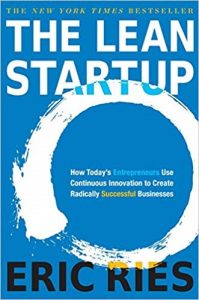 One recent book that captures many principles of Lean Innovation is The Lean Startup by Eric Ries. Ries applies several concepts of Lean thinking to the realm of startups. Here, there is huge uncertainty about the success of the innovation and business model.
One recent book that captures many principles of Lean Innovation is The Lean Startup by Eric Ries. Ries applies several concepts of Lean thinking to the realm of startups. Here, there is huge uncertainty about the success of the innovation and business model.
A few of the key ideas are:
- Working smarter, not harder: the key question is not “can this product be built?” but rather “should this product be built?” and “will this result in a sustainable business?”
- Developing a Minimal Viable Product (MVP): the MVP should be easy to build and contain only the features you want to test with customers.
- Using the Build-Measure-Learn feedback loop to test the MVP, measure results, and adjust the innovation based on the results.
- Innovation Accounting is a better way to hold startups accountable when traditional business metrics don’t work.
The Build-Measure-Learn Feedback Loop
Too many companies begin with an idea for a product they think people want and spend months or years developing it before they validate their initial assumptions. It is better to test your assumptions as soon as possible. Ries shares a simple cycle to follow that focuses on customer feedback.
The Build-Measure-Learn feedback loop is actually very similar to the Plan-Do-Check-Adjust (PDCA) loop we teach at Lean East. Ries explains that the first step of his Build-Measure-Learn loop is to plan the activity by following the loop in the reverse order:
“We figure out what we need to learn, use innovation accounting to figure out what we need to measure to know if we are gaining validated learning, and then figure out what product we need to build to run that experiment and get that measurement.”
Build-Measure-Learn = PDCA
Both the Build-Measure-Learn feedback loop and the PDCA cycle encourage experimentation. The main difference between the two approaches is the speed of iterations.
PDCA is often seen as a slow-paced process where the steps in the planning phase are detailed enough to uncover a simple solution that lasts. For process improvement, the planning stage in PDCA can often take longer than the three other steps combined.
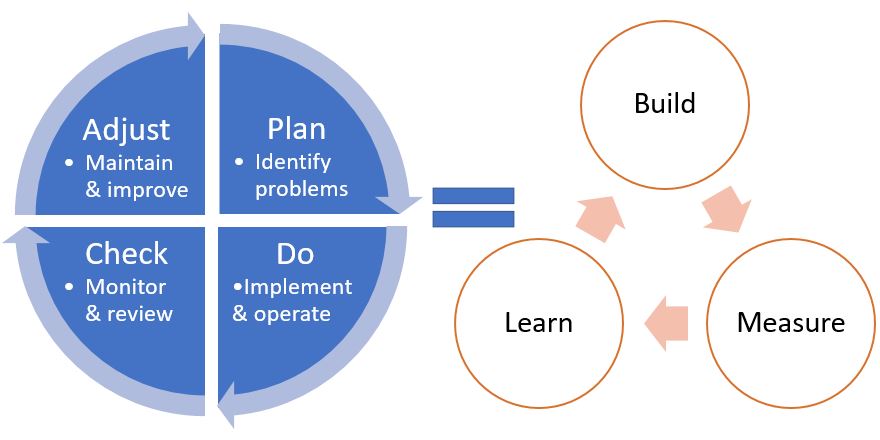
Due to the extreme uncertainty and complexity of today’s innovation, real customer value often cannot be known in advance. Thus, a product development cycle should favor rapid customer feedback. By focusing on experimentation to learn what customers value earlier in the process, innovators can learn when to push forward and when to pivot. When uncertainty is high it is better to prioritize customer feedback (see Ready . . . Fire! . . . Aim) and minimize planning.
Minimal Viable Product (MVP)
Use a prototype of your product or service for your experiment that contains only the minimum features you want to measure and learn about. Eric Ries describes his experience leading a software startup that didn’t focus on an MVP. His team worked hard for six months to ensure their software product integrated well with multiple existing platforms. However, integrating with just one would have been enough to run a test. When they eventually showed the product to customers they learned nobody wanted it. The company ultimately pivoted to a new business model, effectively wasting his six months of effort.
Ries laments that instead of coding for six months he could have set up a product download page for the software (with a fake download link) in a few hours and spent the rest of his time relaxing on a tropical island. The learning (that customers didn’t want the product) would have been the same sitting on the island! This is a wonderful example of working smarter, not harder.
Innovation Accounting
Ries defines innovation accounting as “a way of evaluating progress when all the metrics typically used in an established company (revenue, customers, ROI, market share) are effectively zero.”
We believe the primary goal when applying Lean Innovation principles is experimentation to learn what customers value. Innovation accounting should, therefore, hold the innovators accountable to this objective. They must focus on leading (predictive) indicators of success. And as your MVP becomes closer and closer to looking like the final product or service, your predictive results should start to approach your goals.
Let’s go back to the earlier example of Ries’s startup. Their goal was to release a new phone app that would make the company money. They had a business plan with the typical “hockey stick” forecast: zero revenue during a development period, followed by slow growth during an adoption period, followed by explosive growth as the application goes viral.
The problem was that the entire forecast was based on unvalidated assumptions and completely made up! The hockey stick forecast was guaranteed to be accurate during the development period (a time of zero revenue), but would likely be wrong once the product was released because growth shape was not informed by real data. Predicted revenue, customer numbers, ROI, and market share numbers can be “guessed” to grow in the shape of an average product release but, this truly provides no insight on your individual product or service or whether it will take on that growth form.
Ries also warns against believing in “vanity” metrics you often see in a press release. Imagine this headline:
New product experiencing exponential sales growth!
This is a true headline for every startup upon receiving your first payment for the product. The big problems occur when the company believes its own hype. Doubling or tripling, or 300x, however you talk about growth, it isn’t the measure you need to truly understand if your innovation is going to have success in the real world.
Innovation Accounting Metrics
If traditional (and vanity) metrics are unhelpful in the startup phase, what are the metrics that you should use for Innovation Accounting? They will vary based on the goals and industry, but here are a few examples:
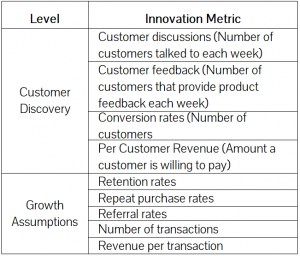
The reason to track the metrics above is to hold the development team accountable to the correct measures. Metrics should be focused on learning from customers and validating your assumptions. Be sure to set targets for each metric above.
Evaluate progress versus your targets as you complete testing on new MVPs and obtain new feedback. Are you exceeding the targets you set or are you falling behind? It is common for teams to learn what customers value is different than your product. When your metrics indicate this, it may be time to pivot to a different solution.
Pivot: A change in strategy without a change in vision
Lean Startup Thinking
In Summary, Lean Innovation applies Lean Startup thinking to the innovation process.
When releasing a new product or service to the world, the goal is to rapidly test your assumptions and obtain feedback from actual customers. Figure out what you want to learn (plan the experiment), run your test using an MVP (do), measure the results and compare them to your hypothesis (check), and adjust based on what you have learned.
Whether you use the Build-Measure-Learn feedback loop or PDCA cycle, the steps are fundamentally the same. When complexity and uncertainty are high it is better to focus on testing the innovation with customers as soon as possible. Ideally, you’d do this in a real-world competitive situation. Use innovation accounting to measure what is important: customer discussions, feedback, conversions, and referral rates. Use the metrics to validate your assumptions and determine whether to pivot or persevere.
The Lean Startup steps might be mistakenly considered easier for a new start-up than for an established company with a brand and reputation to uphold. Lean East disagrees and will share more examples of Lean innovation for established organizations in our next blog post.

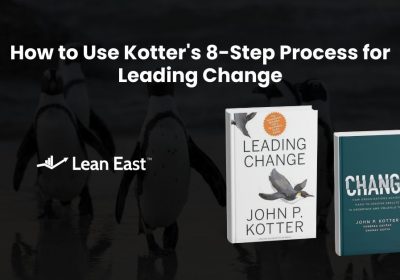
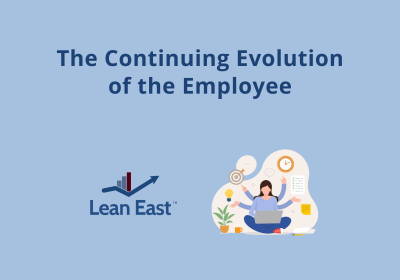


Nice post and I really appreciate your hard work. Blog commenting is also a best medium to share our views. Nice article you have shared.